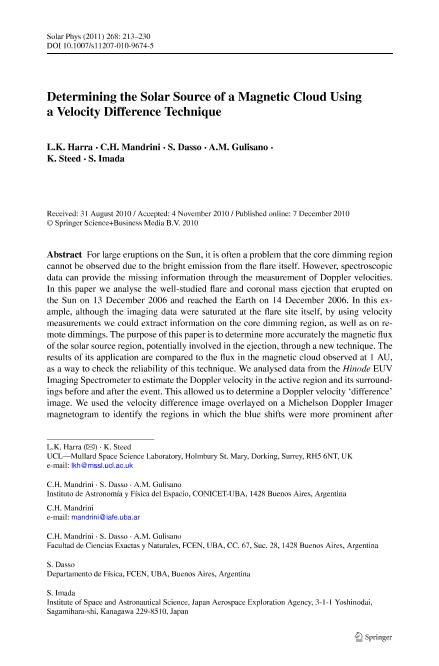Mostrar el registro sencillo del ítem
dc.contributor.author
Harra, L. K.
dc.contributor.author
Mandrini, Cristina Hemilse

dc.contributor.author
Dasso, Sergio Ricardo

dc.contributor.author
Gulisano, Adriana Maria

dc.contributor.author
Steed, K.
dc.contributor.author
Imada, S.
dc.date.available
2019-05-21T13:39:56Z
dc.date.issued
2011-01
dc.identifier.citation
Harra, L. K.; Mandrini, Cristina Hemilse; Dasso, Sergio Ricardo; Gulisano, Adriana Maria; Steed, K.; et al.; Determining the Solar Source of a Magnetic Cloud Using a Velocity Difference Technique; Springer; Solar Physics; 268; 1; 1-2011; 213-230
dc.identifier.issn
0038-0938
dc.identifier.uri
http://hdl.handle.net/11336/76770
dc.description.abstract
For large eruptions on the Sun, it is often a problem that the core dimming region cannot be observed due to the bright emission from the flare itself. However, spectroscopic data can provide the missing information through the measurement of Doppler velocities. In this paper we analyse the well-studied flare and coronal mass ejection that erupted on the Sun on 13 December 2006 and reached the Earth on 14 December 2006. In this example, although the imaging data were saturated at the flare site itself, by using velocity measurements we could extract information on the core dimming region, as well as on remote dimmings. The purpose of this paper is to determine more accurately the magnetic flux of the solar source region, potentially involved in the ejection, through a new technique. The results of its application are compared to the flux in the magnetic cloud observed at 1 AU, as a way to check the reliability of this technique. We analysed data from the Hinode EUV Imaging Spectrometer to estimate the Doppler velocity in the active region and its surroundings before and after the event. This allowed us to determine a Doppler velocity 'difference' image. We used the velocity difference image overlayed on a Michelson Doppler Imager magnetogram to identify the regions in which the blue shifts were more prominent after the event; the magnetic flux in these regions was used as a proxy for the ejected flux and compared to the magnetic cloud flux. This new method provides a more accurate flux determination in the solar source region. © 2010 Springer Science+Business Media B.V.
dc.format
application/pdf
dc.language.iso
eng
dc.publisher
Springer

dc.rights
info:eu-repo/semantics/openAccess
dc.rights.uri
https://creativecommons.org/licenses/by-nc-sa/2.5/ar/
dc.subject
Coronal Mass Ejections: Interplanetary
dc.subject
Coronal Mass Ejections: Low Coronal Signatures
dc.subject.classification
Astronomía

dc.subject.classification
Ciencias Físicas

dc.subject.classification
CIENCIAS NATURALES Y EXACTAS

dc.title
Determining the Solar Source of a Magnetic Cloud Using a Velocity Difference Technique
dc.type
info:eu-repo/semantics/article
dc.type
info:ar-repo/semantics/artículo
dc.type
info:eu-repo/semantics/publishedVersion
dc.date.updated
2019-05-14T21:19:09Z
dc.journal.volume
268
dc.journal.number
1
dc.journal.pagination
213-230
dc.journal.pais
Alemania

dc.journal.ciudad
Berlin
dc.description.fil
Fil: Harra, L. K.. Colegio Universitario de Londres; Reino Unido
dc.description.fil
Fil: Mandrini, Cristina Hemilse. Consejo Nacional de Investigaciónes Científicas y Técnicas. Oficina de Coordinación Administrativa Ciudad Universitaria. Instituto de Astronomía y Física del Espacio. - Universidad de Buenos Aires. Facultad de Ciencias Exactas y Naturales. Instituto de Astronomía y Física del Espacio; Argentina
dc.description.fil
Fil: Dasso, Sergio Ricardo. Consejo Nacional de Investigaciónes Científicas y Técnicas. Oficina de Coordinación Administrativa Ciudad Universitaria. Instituto de Astronomía y Física del Espacio. - Universidad de Buenos Aires. Facultad de Ciencias Exactas y Naturales. Instituto de Astronomía y Física del Espacio; Argentina. Universidad de Buenos Aires. Facultad de Ciencias Exactas y Naturales. Departamento de Física; Argentina
dc.description.fil
Fil: Gulisano, Adriana Maria. Consejo Nacional de Investigaciónes Científicas y Técnicas. Oficina de Coordinación Administrativa Ciudad Universitaria. Instituto de Astronomía y Física del Espacio. - Universidad de Buenos Aires. Facultad de Ciencias Exactas y Naturales. Instituto de Astronomía y Física del Espacio; Argentina
dc.description.fil
Fil: Steed, K.. Colegio Universitario de Londres; Reino Unido
dc.description.fil
Fil: Imada, S.. No especifíca;
dc.journal.title
Solar Physics

dc.relation.alternativeid
info:eu-repo/semantics/altIdentifier/doi/http://dx.doi.org/10.1007/s11207-010-9674-5
Archivos asociados
